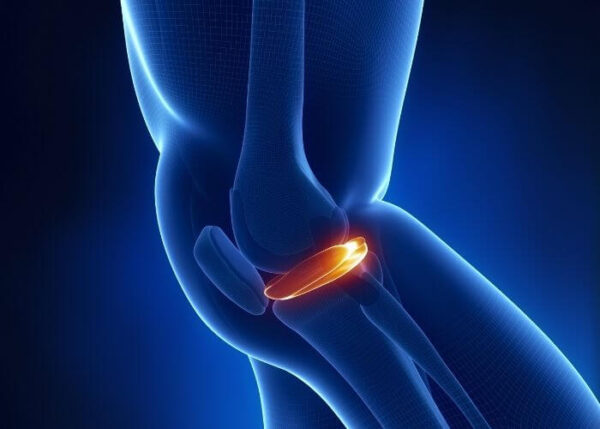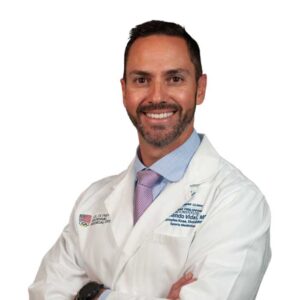The meniscus has a root?
Much like a tree, the meniscus has roots – two of them to be exact. These roots are critical to the health and function of the meniscus and are responsible for transmitting load across the surface of the tibia. Each meniscus has a posterior (back) and anterior (front) root. These two roots are the attachment points of the meniscus to the bone. Without them, the meniscus can extrude (squirt out) and is unable to do its job and transmit load.

What is a meniscal root tear?
A meniscus root tear occurs when the attachment to the bone is torn or destabilized. Most tears of this nature occur very close to the actual root, in the meniscus itself, and are called radial root tears. These make up 90% of all meniscal root tears. Dr. Armando Vidal, orthopedic knee surgeon has extensive experience with meniscus root tears and can help patients in Vail, Aspen and the surrounding Denver, Colorado communities.
Why does it matter where the meniscus tears?
The roots are critical structures and when compromised can result in significant biomechanical problems in the knee joint. Did you know that an unstable meniscal root tear is the biomechanical equivalent of having no meniscus at all? When there is a tear, loads across the joint can soar to over three times of the normal joint load! Patients with a meniscus root tear can experience early onset arthritis, fractures, and failure of other knee treatments, such as a ligament reconstruction graft. In healthy (non-arthritic) knees we are aggressive about repairing these tears to restore normal biomechanics to the knee. For this reason, Dr. Vidal and his fellow orthopedic knee surgeons at The Steadman Clinic have invested a lot of research into meniscus root repairs.
Do only athletes experience meniscus root tears?
There are two groups of individuals who suffer meniscal root tears with athletes being the second largest group. Patients in their 50’s make up the largest group and the tear usually occurs without major trauma. Oftentimes, a patient will report a “pop” in their knee with deep flexion, squatting, lifting or other seemingly innocuous activities – like tying their shoe! Frequently the initial pain is minor but escalates quickly in the subsequent days or weeks, to very high levels.
These types of meniscal root tears can be more severe and cause greater problems of osteoarthritis, osteonecrosis, insufficiency fractures and swelling. These injuries are often misdiagnosed or missed on MRI. Dr. Vidal and his team at the Steadman Clinic are experts in the diagnosis and treatment of these injuries for patients Vail, Aspen and the surrounding Denver Colorado communities.
What are the symptoms of a meniscus root tear?
The most common symptom of a meniscal root tear is knee pain, especially at the back and medial side of the knee. Patients report hearing or feeling a “pop” at the time of injury. The pain can be intense in many cases to the point that patients present with a limp or are even on crutches. Long-standing root tears can change the gait of the patient and cause early osteoarthritis.
How is a meniscus root repair done?
When the meniscus root tears, it pulls away from the bone or tears very close to the bony attachment. The goal is to take the torn root and tack it down to the bone using strong sutures. It is important the placement of the root match the original “foot print” and the root is placed where it was before the injury. It is a technically challenging procedure, so it is important to be evaluated by a team who is well versed and experienced in these procedures.
During the procedure, Dr. Vidal will isolate the root, pull it against the tibia and place sutures in the meniscal attachment. He then drills a hole from the front of the tibia, into the root area and brings the sutures through the hole in order to tie them together and hold the tissue in place. In some cases, Dr. Vidal will need to clean out any scar tissue that has accumulated to reposition the root correctly so it will not be under tension when the knee moves through its full range of motion.
What is the recovery like after meniscus root repair?
Dr. Vidal and his team will work with patients in Vail, Aspen and the surrounding Denver, Colorado communities to form an individualized set of post-operative protocol for maximum healing success. Typically, patients are non-weightbearing for 6 weeks after surgery. Physical therapy in the first phase is limited because of the postoperative restrictions. We often employ a CPM (continuous passive motion) machine for the first 4 weeks for 3-4 hours per day. After 6 weeks, patients may begin to put weight on the knee but should avoid any squatting, squatting and lifting, or even sitting cross-legged for 5-6 months. A stationary bike can begin to be used after the initial 6-weeks healing time post-op.
Meniscus Restoration Surgeon
Have you experienced intense knee pain, including a popping noise at the time of injury? If so, you may have experienced a type of meniscal injury called a meniscus root tear. These injuries are serious and must be evaluated and treated promptly, otherwise it could result in long-term consequences. Meniscus restoration surgeon, Doctor Armando Vidal provides diagnosis as well as arthroscopic stabilization surgery for patients in Vail, Aspen, and the surrounding Denver, Colorado communities who are meniscal root tears. Contact Dr. Vidal’s team today!

Locations
180 S Frontage Rd W
Vail, CO 81657
226 Lusher Court
Ste 101
Frisco, CO 80443
322 Beard Creek Road
Edwards, CO 81632


